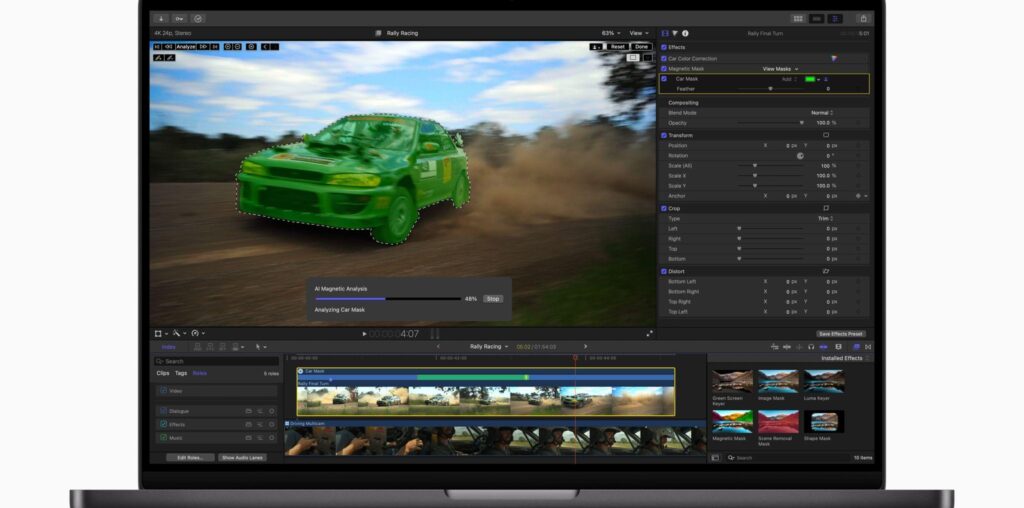Today, Apple revealed the latest updates to Final Cut Pro for the Mac and iPad, with both offering a variety of new features and simplified workflows.
Final Cut Pro 11 for the Mac has added magnetic masks, extending the “magnetic” metaphor used for clips placed on your timeline. Apple says the new feature will allow you to quickly mask people and objects in a shot to color grade them or add effects separately from the rest of a scene.
The app can automatically generate closed captions now, too. The feature, which was briefly shown off in a video published alongside the announcement of the new Mac mini, uses artificial intelligence to convert dialogue into text.
Final Cut Pro 11 is also now capable of editing spatial video for the Apple Vision Pro. In its press release, Apple says:
Final Cut Pro 11 now supports spatial video editing, allowing editors to import their footage and add effects, make color corrections, and enhance their projects with titles. The depth position of titles and captured footage can also be adjusted during the editing process. Spatial video clips can be captured directly with Vision Pro, or on iPhone 15 Pro, iPhone 16, iPhone 16 Pro, and Canon’s new RF-S7.8mm F4 STM DUAL lens paired with Canon R7.
Final Cut Pro for the iPad has been updated to version 2.1 with several new features. I’ve been using Final Cut Pro more regularly since we started the MacStories YouTube channel, and one of the limitations I noticed immediately is that the color correction tools in the iPad version weren’t nearly as good as on the Mac. The iPad’s color tools still aren’t as sophisticated as what’s available on the Mac, but this update does add new color grading presets as well as a new Enhance Light and Color feature that intelligently applies color, contrast, brightness, and color balance to a video and works with SDR, HDR, RAW, and Log-encoded media.
Live Drawing on a video has been expanded with new brushes, too. There are new watercolor, crayon, fountain pen, and monoline pen brushes, letting users create a greater variety of looks for their videos. Other new effects include a picture-in-picture effect, callouts, and a set of built-in soundtracks. I’m eager to try picture-in-picture, which should be a good way to create tutorials and other types of videos and callouts; it’s an effect available from multiple third-party effects vendors on the Mac, but new to the iPad.
The iPad version of Final Cut Pro is also adding a host of other new features, including:
- the ability to expand clips in the timeline vertically with a pinch gesture,
- dynamic adjustments to the size of the picture-in-picture window,
- support for editing high-frame-rate video, and
- Apple Pencil Pro haptic feedback for timeline scrubbing and dropping effects onto the timeline.
Final Cut Pro Camera is being updated as well. Custom LUTs are still not available, but Apple has added its LOG LUT for color grading footage, which can be previewed while recording. Users can also record in LOG HEVC, which will preserve the benefits of shooting in LOG, but with much smaller files than, say, Apple ProRes.
The camera app has also added a level for filming top-down footage, which the Apple Camera app has had for some time, and support for recording in 4K at up to 120fps on the iPhone 16 Pro line.
It’s great to see all three Final Cut Pro apps get updates today. I’ve been using them all more regularly and like using the iPad app the most, although it’s frustrating at times knowing that the deep catalog of third-party effects plug-ins available on the Mac aren’t available on the iPad. Apple said third-party plug-ins were coming to the iPad version when Final Cut Pro launched on the device, but here we are about 18 months since its debut, and not a single company offers plug-ins for the iPad. The ability to apply custom LUTs on the iPad is another request I hear a lot from users. Hopefully, both features will make their way to the iPad eventually.
Final Cut Pro 11 for the Mac and Final Cut Camera are free updates to the existing versions, Final Cut Pro for iPad’s subscription pricing remains $4.99/month or $49.99/year, and all apps are available on the App Store.
Apple also released an update to Logic Pro for the Mac and iPad, adding a new Quantec Room Simulator plug-in that recreates ‘80s-era hardware invented by Wolfgang “Wolf” Buchleitner. The plug-in simulates room acoustics in a natural-sounding way that has been used in a wide variety of recordings.
Among the artists to have used Quantec Room Simulator hardware is Peter Gabriel, who had this to say about Apple’s new Logic Pro plug-in:
The Quantec Room Simulator has been a key element to my sound for many years, appearing on records like Passion and Us. I also used it to build harmonic drones to start my live set, which then evolved into songs like ‘Across the River.’ It’s wonderful that Apple is bringing the Quantec QRS back to life as a plug-in for Logic users around the world.
Although I probably don’t have a use for it, I love the idea of recreating the Quantec Room Simulator as a plug-in that’s available to anyone who uses Logic.
On both the Mac and iPad, Logic also adds a new option to Reorder Mixer Channels, which allows users to rearrange channel strips by dragging and dropping them. Finally, the iPad version introduces Sample Folders to help musicians organize their sound samples.
Logic Pro 11.1 for the Mac is available as a free update to existing users, and Logic Pro for iPad’s subscription pricing remains $4.99/month or $49.99/year.

